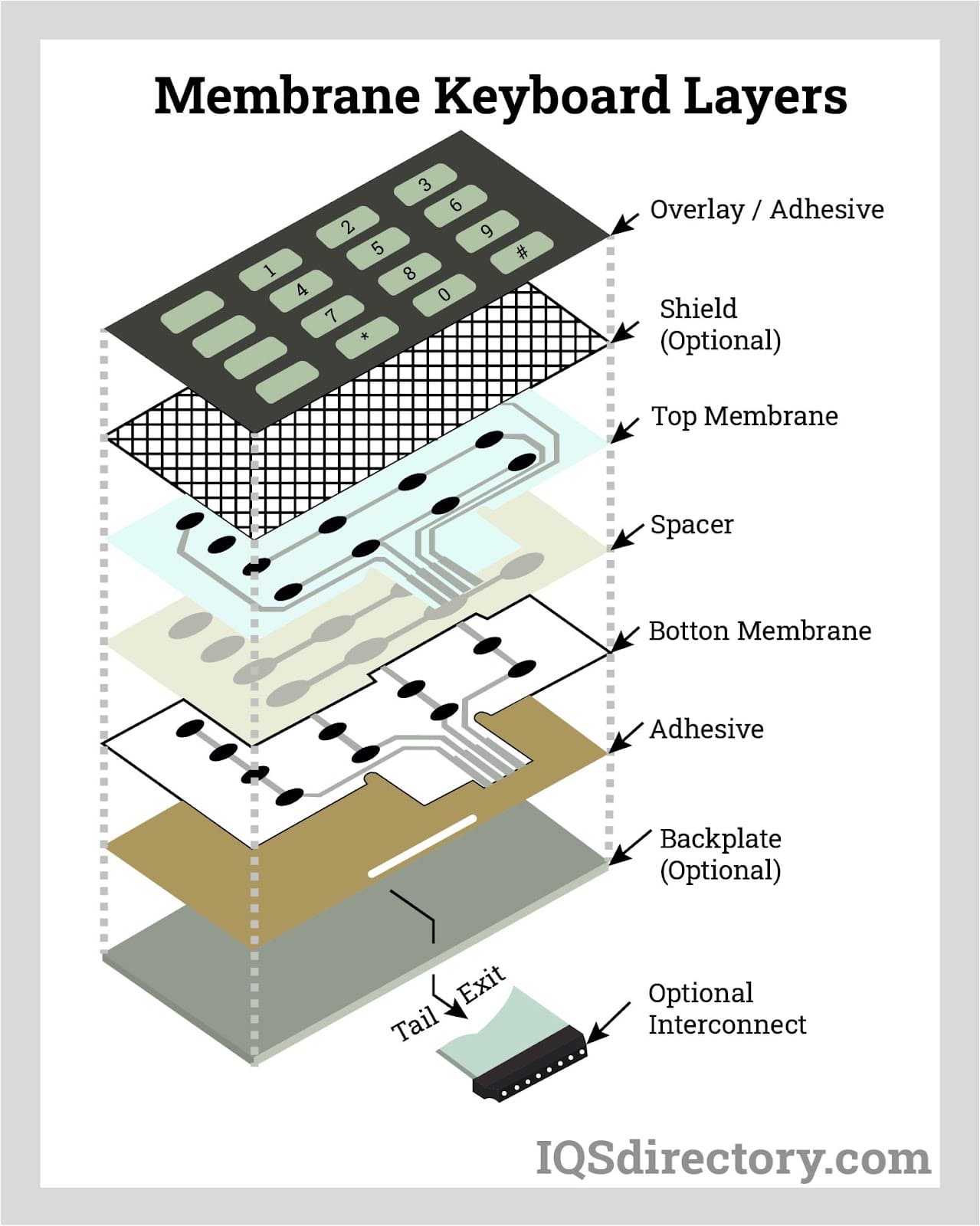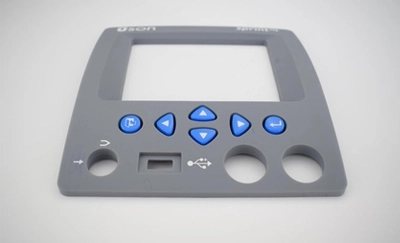The role of membrane switch in connected consumer appliances
The Production Process Behind Membrane Layer Switch: What You Required to Know
The manufacturing procedure behind membrane switches over combines careful layout, material option, and quality assurance. It starts with comprehending the intricacies of membrane layer button style and proceeds with numerous stages, consisting of material options and printing strategies. Each phase plays an important duty in ensuring performance and resilience. Nonetheless, the complexities of layer building and the strenuous testing requirements might reveal understandings that are not immediately obvious. What exists past these foundational aspects?
Recognizing Membrane Layer Switch Design
Membrane layer buttons might show up basic at initial glance, their design involves elaborate factors to consider that assure capability and longevity. The design process starts with a comprehensive understanding of individual demands, including the interface's intended application and ecological variables. Ergonomics is a crucial element, as the design should assist in simplicity of use while guaranteeing that tactile feedback meets user expectations.Moreover, the layering of parts, such as visuals overlays, glue layers, and conductive traces, need to be exactly engineered. membrane switch. This layered configuration not just affects the switch's responsiveness but also influences its long life. Interest is provided to the sealing techniques used to secure against moisture and dirt, which might jeopardize performance. In addition, style considerations reach aesthetics, where color pattern and visual quality improve user experience. Inevitably, the style of membrane switches over equilibriums functionality, customer experience, and toughness, guaranteeing that they fulfill the needs of various applications properly
Materials Used in Membrane Layer Switch Production
When selecting products for membrane button manufacturing, it is necessary to consider both efficiency and toughness. The primary products include polyester and polycarbonate movies, which provide versatility and strength. These films are often covered with glue to ensure correct bonding to substrates. Conductive inks, normally composed of silver or carbon, are important for creating electrical links within the switch, permitting reliable operation.Additionally, a protective layer, such as a tough coat, is often related to boost scratch resistance and durability. The selection of backing material, such as acrylic or foam, can significantly influence the switch's tactile feel and total user experience. Numerous ecological factors, including temperature and humidity, must lead product selection to guarantee peak performance in particular applications. Eventually, the appropriate mix of products adds to the membrane button's functionality and life expectancy, making informed options crucial for producers.
The Printing Process: Creating Graphics and Text
The printing process in membrane switch manufacturing plays a considerable function in creating premium graphics and message. Different graphic style methods are employed to ensure visual charm and functionality, while careful ink selection methods are essential for resilience and performance. Recognizing these components is basic for attaining finest results in membrane switch layout.
Graphic Layout Techniques
Graphic style methods play an important duty in the printing procedure of membrane buttons, as they define just how graphics and message will ultimately show up on the final item. Efficient graphic layout involves the critical use of formats, fonts, and shades to enhance readability and aesthetic appeal. Developers frequently make use of vector graphics for scalability, guaranteeing that photos remain sharp at different dimensions. Furthermore, focus to contrast and positioning is vital, as it influences customer interaction and aesthetic top quality. The incorporation of branding aspects, such as logo designs, should be managed with treatment to maintain brand honesty. Overall, thoughtful graphic layout strategies contribute significantly to the capability and attractiveness of membrane buttons, influencing user experience and product performance.
Ink Option Techniques
Picking the suitable ink is necessary for attaining the desired visual high quality and toughness in membrane layer button production. Various ink types are used, consisting of solvent-based, water-based, and UV-curable inks. Each kind supplies distinctive characteristics, such as resistance, attachment, and adaptability to ecological factors. Solvent-based inks are often favored for their durability and vivid colors, while water-based inks are a lot more eco-friendly however might have limitations in bond. UV-curable inks give rapid healing and durable performance. In addition, color matching methods ensure that the chosen inks align with design requirements. Inevitably, the selection of ink need to think about elements such as application method, substrate compatibility, and end-use needs to attain remarkable lead to membrane button graphics and message.
Layer Building and Assembly

Product Option Refine
A mindful option of products is important in the manufacturing process of membrane switches, as it directly influences functionality and sturdiness. The main products utilized include polyester, polycarbonate, and different conductive inks. Polyester is commonly preferred for its exceptional resistance to chemicals and abrasion, making it appropriate for extreme atmospheres. Polycarbonate, on the various other hand, supplies remarkable clearness and effect resistance, which is useful for applications needing exposure and robustness. Conductive inks, generally composed of silver or carbon, are vital for developing trusted electric paths. Furthermore, the choice of adhesive products affects the general integrity of the button - membrane switch. Reviewing aspects such as environmental exposure, responsive comments, and aesthetic needs overviews producers in selecting the very best products for their particular applications
Layer Adhesion Strategies
Adhering layers in membrane button building is a vital procedure that ensures functionality and long life. Different adhesion methods are employed to safeguard optimal bonding between layers, which commonly include using adhesives, warm, and pressure. Pressure-sensitive adhesives (PSAs) are frequently utilized for their convenience of application and instant bonding capacities. Furthermore, thermal bonding strategies can be applied, where warmth is utilized to turn on sticky properties, safeguarding a strong bond. The option of attachment method greatly depends on the products entailed and the certain application requirements of the membrane layer switch. Correct positioning and consistent application of adhesives are necessary to stop issues, protecting the read the article button runs efficiently throughout its desired life-span.
High Quality Control Procedures
Guaranteeing quality assurance throughout the layer building and construction and assembly of membrane buttons is crucial for maintaining performance and integrity. This procedure generally includes a number of critical steps, including detailed inspections at each stage of production. Makers use innovative screening approaches, such as peel tests and top article adhesion assessments, to confirm the stability of layer bonds. Furthermore, aesthetic assessments are performed to recognize any kind of issues in printing or product inconsistencies. Environmental conditions, such as temperature and moisture, are carefully monitored to guarantee ideal curing and adhesion. Routine calibration of equipment helps keep specific production requirements. By carrying out these high quality control steps, manufacturers can greatly reduce the threat of item failure, guaranteeing that the last membrane layer changes meet the called for requirements and client expectations.
Examining and Top Quality Control Procedures

Advancements in Membrane Layer Switch Technology
As advancements in modern technology continue to evolve, membrane layer switches are gaining from cutting-edge advancements that enhance their performance and user experience. click this link One remarkable advancement is the integration of capacitive touch modern technology, which enables more instinctive and responsive customer interfaces. This shift not just improves appearances however also minimizes mechanical wear and tear, prolonging the lifespan of the switches.Additionally, improvements in graphic overlay materials have actually resulted in boosted resilience and resistance to ecological factors such as wetness and UV light. These products now use enhanced clearness and illumination, further raising the aesthetic appeal.Furthermore, the incorporation of wise modern technology is transforming membrane changes right into interactive control panels, allowing connection with IoT tools. This connectivity promotes a smooth customer experience, leading the way for applications in numerous sectors, from healthcare to consumer electronic devices. Jointly, these innovations position membrane changes as essential components in modern gadget style.
Often Asked Inquiries
For how long Does the Membrane Switch Manufacturing Process Take?
The duration of the membrane switch manufacturing process can vary significantly. Aspects such as intricacy, products made use of, and manufacturing quantity impact timelines, with regular manufacturing varying from a couple of days to numerous weeks for conclusion.
What Are the Usual Applications for Membrane Layer Buttons?
Membrane layer buttons are frequently used in different markets, including automobile controls, home home appliances, medical devices, and customer electronic devices (membrane switch). Their convenience and longevity make them ideal for applications calling for straightforward user interfaces and trustworthy efficiency in diverse environments
Can Membrane Layer Switches Over Be Personalized for Certain Requirements?

What Is the Lifespan of a Common Membrane Change?
The life-span of a typical membrane switch varies, however normally, it varies from 1 to 5 million cycles. Aspects such as use, setting, and worldly top quality greatly influence resilience and general performance gradually.

Are Membrane Layer Changes Ecologically Friendly?
The environmental friendliness of membrane layer switches over differs. Some materials used might not be recyclable, while others can be eco-friendly. The total effect depends upon manufacturing practices and products, necessitating mindful factor to consider during selection and disposal. The production process behind membrane switches over combines cautious design, product choice, and quality control. It begins with understanding the details of membrane switch layout and progresses with various phases, including material selections and printing methods. When selecting products for membrane button manufacturing, it is important to ponder both performance and resilience. A mindful choice of products is necessary in the manufacturing procedure of membrane buttons, as it directly affects functionality and toughness. The choice of attachment method greatly depends on the materials entailed and the specific application needs of the membrane switch.